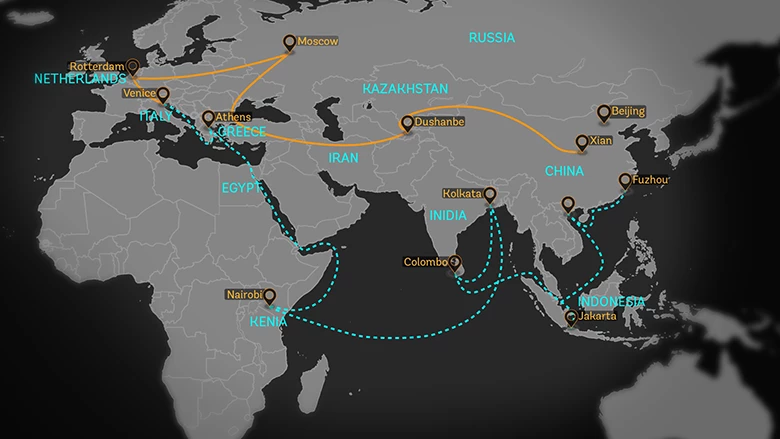The Belt and Road Initiative (BRI) is an ambitious effort to deepen regional cooperation and improve connectivity on a trans-continental scale. While the scope of the initiative is still taking shape, the BRI consists primarily of the Silk Road Economic Belt, linking China to Central and South Asia and onwards to Europe, and the New Maritime Silk Road, linking China to the nations of South East Asia, the Gulf Countries, North Africa, and on to Europe. Six other economic corridors have been identified to link other countries to the Belt and the Road.
The World Bank Group has began to analyze the economics of the BRI. As a way to stimulate an informed debate, we outline three opportunities and three risks associated with the initiative.
Opportunities- Tremendous size and scope. BRI economies account for one-third of global GDP and trade, and close to two-thirds of world population. For some BRI countries, poverty ratios, the percentage of the population living below the poverty line ($1.90 a day), are still high - 25 percent in Kenya, 23 percent in Uzbekistan and Djibouti, and 21 percent in Laos. If BRI projects are successful, they stand to benefit a large number of poor people and huge swaths of the world’s economies, with large positive spillover effects on global welfare.
- Large unexploited potential. BRI economies are increasingly integrated with the rest of the world and with each other. BRI countries’ contribution to global exports has nearly doubled in the last two decades. But a handful of BRI economies, most notably China, are responsible for the lion’s share of these exports. Trade of many BRI economies such as Afghanistan, Nepal, Tajikistan, and Laos is below potential due to inadequate infrastructure, weak policy and other gaps. If successful, the BRI could contribute to fill these gaps, boosting international commerce, particularly for countries that have been unable to fully integrate in the world economy.
- Improving connectivity. It currently takes about 30 days to ship goods from China to Central Europe, with most goods being transported by sea. Shipping goods by train can cut transit time in half, but costs much more. There is a tradeoff between saving time and saving money: each day’s delay in getting an item from the factory gate to the consumer is estimated to reduce trade by one percent. Improving the capacity and network of railways and other transport infrastructure could lead to more cross-border trade, increased investment, and improved growth in BRI economies. Regional cooperation on infrastructure improvements is needed to solve this challenge. If successful, BRI projects stand to make trade easier in some of the world’s most important economic corridors.
- Policy barriers create thick borders. On average, delays crossing borders, cumbersome customs procedures, and restrictions on foreign direct investment (FDI), tend to be more significant in BRI countries compared to other regions. Doing Business indicators show that in Central Asia, for example, it can take up to 50 days to comply with all procedures to import goods. It takes less than 10 in G7 countries. BRI countries have more restrictive and burdensome FDI policies than high-income OECD countries, in terms of starting a foreign business, accessing industrial land, and arbitrating commercial disputes. This is why policy reform and cooperation must complement infrastructure projects to boost connectivity.
- Risks involved with major infrastructure projects. There are potential environmental, social, and corruption risks associated with any large infrastructure project. These could include, for example, biodiversity loss, environmental degradation, or elite capture. These risks may be especially significant in countries involved in the BRI, which tend to have relatively weak governance. These risks will need to be identified and safeguards put in place to minimize their potential negative effects. The WBG and other Multilateral Development Banks could play a role in supporting the implementation of high environment, social and governance standards for BRI investments.
- Macro risks. For some countries, the financing required for BRI projects may expand debt to unsustainable levels. For instance, the construction of the Lao PDR section of the Kunming -Singapore Railway has an estimated cost of US$ 6 billion – nearly 40 percent of GDP of Laos in 2016. The authorities are attempting to contain the impact of the project over public finances by limiting their participation to around US$ 0.7 billion, out of which US$ 0.5 billion financed by a Chinese loan to the Government of Lao PDR. The Center for Global Development recently estimated that BRI projects will increase debt to GDP ratios for several BRI countries, putting eight at high risk. Countries participating in BRI projects will need to balance the need for these development projects with the vulnerabilities created by increased debt levels.
- An assessment of the current connectivity gaps (e.g. transport, communications, trade, investment) in BRI countries.
- An assessment of the potential economic effects of proposed BRI infrastructure, including the impact on international trade, cross-border investment, allocation of economic activity, and inclusive growth in the BRI countries.
- Identification of complementary policies and institutions that will enhance the development benefits for all BRI countries, including, for example, trade, investment and procurement reforms, and social, environmental and governance safeguards.



Join the Conversation